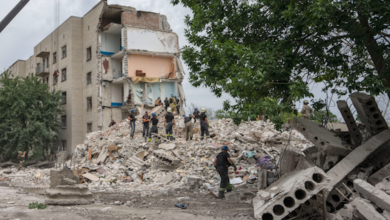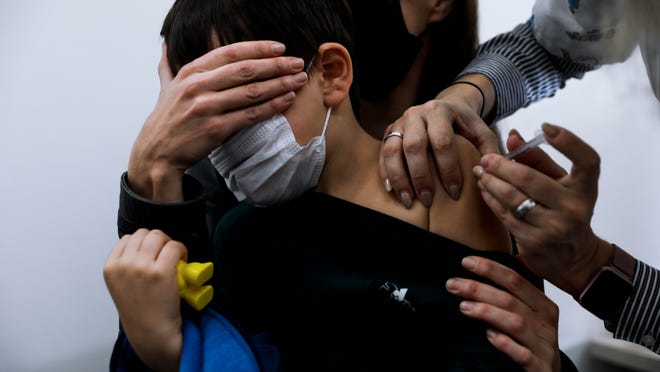
The number of COVID-19 patients in the Cincinnati region's hospitals has jumped 21% in the last seven days and now is at the highest level since February.
The number of in-house patients on Tuesday was 363, up from 303 on Aug. 18, increasing the pressure on the region's health care system as the more contagious delta variant of the novel coronavirus continued to spread in the area.
The local seven-day rate of positive COVID-19 cases now is 9.4%, the highest level in weeks. The positivity rate is highest among people ages 5-17, standing at 13.3% of those tested.
The seven-day moving average of the number of occupied medical-surgical beds stood at 2,413 on Wednesday, according to data on the Health Collaborative Situational Dashboard.
That's above the level that causes moderate to extreme strain on staffing at local hospitals, public health officials say.
Back to school:What you need to know about masks, quarantines
Vaccine boosters: Who should get them and why

The seven-day average for the number of occupied intensive care unit beds was 489, continuing to rise in the range that causes moderate to extreme strain.
The ICUs had been operating at normal levels as recently as late July, the data for the Health Collaborative (the trade group for the region's hospitals) shows.
The number of COVID-19 positive patients in local hospitals has risen from 50 on July 10 to 303 on Aug. 18.
The number of COVID-19 patients in local ICUs has risen from 20 on July 19 to 87 on Aug. 18.
The number of COVID-19 patients on ventilators on Aug. 18 was 63, up from 43 on Aug. 9.
The status of the hospitals comes in the wake of the fourth wave of the COVID-19 pandemic across the Cincinnati region.
Increases in hospitalizations and ICU admissions typically follow increases in new cases of COVID-19 infection, and the numbers on that front have been rising in the past several weeks.
Politics:As more require COVID-19 vaccine, Ohio lawmakers move up debate on 'vaccine choice' bill
Delta variant:What's the difference between KF94 and KN95 masks?
All of the Cincinnati region's 16 counties remain flagged at the "red" level by public health officials for reaching the highest level of COVID-19 transmission.
People living in all 16 counties in the region should be wearing masks indoors, even if they're vaccinated against COVID-19, based on federal health recommendations and current novel coronavirus transmission levels.
Where is COVID-19 especially strong now?
The Health Collaborative's dashboard also identifies local ZIP codes with the highest per capita rates of cases over the last 14 days.
On Aug. 24, those were 45225 (Camp Washington, Villages at Roll Hill, East Westwood, Millvale and part of North Fairmount), 45232 (Spring Grove Village and Winton Hills), 45204 (Lower Price Hill, Sedamsville, Riverside and part of East Price Hill), 45205 (parts of East Price Hill and West Price Hill) and 45214 (West End and part of South Fairmount).
Those are the same ZIPs that had the highest level of cases on Aug. 18.
The vaccination rates in each of those five ZIPs is below 40%.
How do we compare with others around the country?
Nationally, 90.4% of counties are at the high level, 5.5% at the substantial level and 1.3% at the moderate level, according to the federal Centers for Disease Control and Prevention.
No counties in Ohio, Kentucky or Indiana are in the low rate of transmission; only 2.8% of counties nationally are at that level.
What does being at higher levels mean?
The CDC is recommending indoor mask-wearing for anybody age 2 or older in public in counties with substantial or high COVID-19 transmission or test positivity rates – places with at least 50 new cases per 100,000 population over the past seven days or a COVID-19 test positivity rate of 4.5% or below.
What else do health officials recommend?
Besides getting vaccinated, the precautions are what they've recommended for most of the pandemic:
- Keep 6 feet away from others outside your home. At home, avoid close contact with people who are sick.
- Avoid crowds and poorly ventilated spaces.
- Wash your hands often. Cover coughs and sneezes. Clean and disinfect high-touch surfaces daily.
- Monitor your health daily. Watch for fever, cough, shortness of breath, loss of taste/smell or other symptoms of COVID-19. Take your temperature if symptoms develop.
In Kentucky, health officials have additionally suggested that medically vulnerable people living in red-zone counties should avoid social activities with unvaccinated people; organizers of large public events should consider postponing them.
USA TODAY Network New York Team contributed.
Source link







